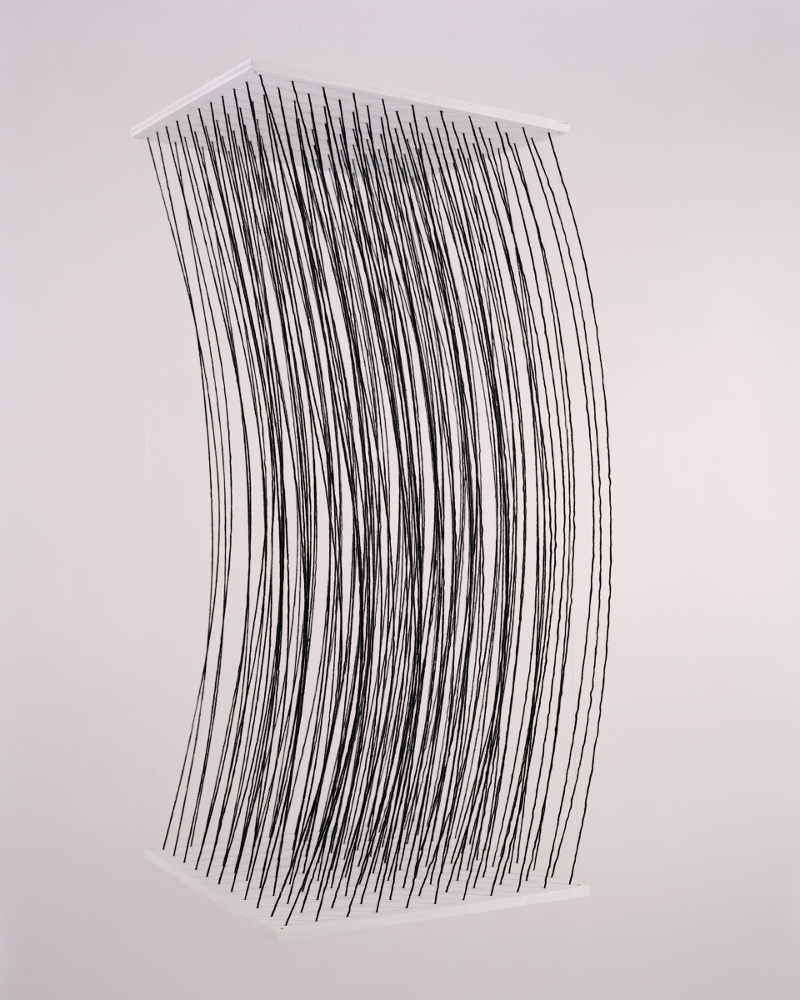Blockchain will change everything: the transportation industry, the financial system, the government ... in fact, it is probably easier to list the areas of our life that it will not affect. In this case, enthusiasm for him is often based on a lack of knowledge and understanding. Blockchain is the solution to the problem.

Sjoerd Knibbeler created this image specifically for The Correspondent; the rest of the images in this article are from the 'Current Studies' series (2013-2016), which you can learn more about at the end of the article.
Imagine: a crowd of programmers in a huge hall. They sit on folding chairs, in front of them are laptops on folding tables. A man appears on a stage illuminated with blue-violet light.
“Seven hundred blockchains! He shouts to his listeners. Pointing to people in the room: - Machine learning ... - and then loudly: - Energetic turn! Healthcare! Public safety and law enforcement! The future of the pension system! "
Congratulations, we are at Blockchaingers Hackathon 2018 in Groningen, The Netherlands ( thankfully, a video). If the speakers are to be believed, history is made here. Earlier, the voice from the accompanying video asked the audience: can they imagine that right here, right now, in this room, they will find a solution that will change “billions of lives”? And with these words, the Earth on the screen explodes with a beam of light rays.

Then the Dutch Interior Minister Raymond Knops appears, dressed in the latest techie fashion - a black sweatshirt. He is here in the role of "super-accelerator" (whatever that means). “Everyone feels that blockchain is going to revolutionize governance,” says Knops.
In recent years, I have been hearing about blockchain all the time. However, like all of us. Because he is everywhere.
And I'm clearly not the only one asking myself a question: who will explain to me what it is all about? And what is its “revolutionary spirit”? What problem does it solve?
Actually, that's why I decided to write this article. I can tell right away: this is a strange journey to nowhere. I have never in my life come across such an abundance of jargon that describes so little. I have never seen such an amount of bombast that was blown away so quickly upon closer examination. And I have never seen so many people looking for a problem for their "solution".
"Agents of Change" in a provincial Dutch town
The residents of Zuidhorn, a town of just under 8,000 in the northeastern Netherlands, had no idea what blockchain was.
“All we knew was that the blockchain was on its way and global changes awaited us,” one of the city officials said in an interview with the news weekly . "We had a choice: sit back or act."
The inhabitants of Zuidhorn decided to act. It was decided to "transfer to blockchain" the municipal program to help children from low-income families. To do this, the municipality has attracted a student and blockchain enthusiast Maarten Veldhuijs for an internship.
His first task was to explain what blockchain is. When I asked him a similar question, he said that this is “ a kind of system that cannot be stopped ”, “force of nature ”, if you like, or rather“ decentralized consensus algorithm ”. “ Okay, it's hard to explain ,” he finally admitted. “ I told the authorities: 'I'd rather make an application for you, and then everything will become clear .'
No sooner said than done.
The assistance program allows low-income families to rent a bicycle, go to the theater or cinema at the expense of the city, etc. In the past, they had to collect a bunch of papers and receipts. But Velthuijs' app changed everything: now it is enough to scan the code - you get a bike, and the business owner gets money.
Suddenly the tiny town became one of the "centers of the global blockchain revolution." Media attention and even accolades followed: the city won the Municipal Innovation Award and was nominated for Best IT Project and Best Civil Service.
The local administration showed more and more enthusiasm. Velthuijs and his team of “disciples” were shaping a new reality. However, this term did not fit well with the excitement that gripped the city. Some residents directly called them "agents of change" (this is a stable expression in English about people who help organizations in transformation - approx. Transl.) .
How does he work?
Okay, change agents, revolution, everything changes ... But what is blockchain?
At its core, blockchain is a well-known spreadsheet (imagine Excel with a single spreadsheet). In other words, this is a new way of storing data. Traditional databases usually have one user responsible for it. It is he who decides who has access to the data and who can enter, edit and delete it. With blockchain, everything is different. No one is responsible for anything, and no one can change or delete data. They can only be entered and viewed .
Bitcoin is the first, most famous and perhaps the only use of blockchain. This digital currency allows you to transfer money from point A to point B without the participation of a bank.

How does he work? Imagine that you need to transfer some amount of money from Jesse to James. Banks are good at this. For example, I ask the bank to send money to James. The bank starts the necessary checks: is there enough money in the account? Is there an account with the specified number? And in his own database he writes something like "transfer money from Jesse to James."
In the case of Bitcoin, things are a little more complicated. You publicly declare in a kind of giant chat: "Transfer one bitcoin from Jesse to James!" Then there are users (miners) who collect transactions into small blocks.
To add these blocks with transactions to a public blockchain ledger, miners have to solve a difficult problem (they need to guess a very large number from a very extensive list of numbers). This task usually takes about 10 minutes to complete. If the time to search for an answer is steadily decreasing (for example, miners are switching to more powerful equipment), the complexity of the task will automatically increase.

Once the answer is found, the miner adds transactions to the latest version of the blockchain - the one that is stored locally with him. And the message goes to the chat: "I solved the problem, look!". Anyone can check and make sure that the solution is correct. After that, everyone updates their local versions of the blockchain. Voila! The transaction is complete. The miner receives bitcoins as a reward for his work.
What is this task?
Why is this task necessary at all? In fact, if everyone was always honest, she wouldn't be needed. But imagine a situation where someone decides to spend their bitcoins twice. For example, I say to James and John at the same time, "Here's your bitcoin." And someone should check that this is possible. In this sense, miners do the job that banks are usually responsible for: they decide which transactions are allowed.
Of course, the miner can try to cheat the system by colluding with me. But an attempt to spend the same bitcoins twice will be immediately exposed, and other miners will refuse to update the blockchain. Thus, a malicious miner will spend resources on solving the problem, but will not receive a reward. Due to the complexity of the problem, the costs of solving it are high enough for that, so it is much more profitable for miners to adhere to the rules.

Alas, this mechanism is highly ineffective. And it would be much easier if data management could be entrusted to a third party (for example, a bank). But this is exactly what Satoshi Nakamoto, the notorious inventor of bitcoin, wanted to avoid. He considered banks to be a universal evil. After all, they can freeze or withdraw money from your account at any time. This is why he came up with Bitcoin.
And bitcoin works. Kriptovalyutnaya ecosystem grows and develops: according to recent estimates, the number of digital currency has passed for 1855 (according to data for February 2020, there are more than 5000 - ca. Perevi..) .
But at the same time, it cannot be said that bitcoin is a runaway success. Only a small percentage of stores accept digital currency, and for good reason. First of all, the payments themselves are very slow (sometimes the payment takes 9 minutes, but there were times when the transaction lasted 9 days!). The payment mechanism is very expensive (try it yourself - it is much easier to open a hard blister with scissors). And finally, the price of Bitcoin itself is extremely volatile (it rose to € 17,000, fell to € 3,000, then jumped back to € 10,000 ...).
But worst of all, we are still far from the decentralized utopia that Nakamoto so dreamed of, namely the elimination of unnecessary "trusted" intermediaries. Ironically, there are only three mining pools (a mining pool is a large-scale concentration of miner computers located somewhere in Alaska or elsewhere far beyond the Arctic Circle), which are responsible for generating more than half of new bitcoins * (and, accordingly , for checking transactions). (At the moment there are 4 of them - approx. Transl.)
*Nakamoto believed that anyone could work on a problem on an equal basis with others. However, some companies have taken advantage of exclusive access to specialized equipment and space. Through such unfair competition, they were able to seize the leading role in the ecosystem. What was meant to be a purely decentralized project has become centralized again. The current level of decentralization for different cryptocurrencies can be viewed here .
In the meantime, bitcoin is much better suited for financial speculation. The lucky one who bought a cryptocurrency for 20 dollars or euros at the dawn of its existence now has enough money for several round-the-world travels.
Which brings us to blockchain. Impenetrable technology that brings sudden wealth is the proven formula for hype. Advisors, managers and consultants learn about the mysterious currency that turns ordinary people into newspaper millionaires. "Hmm ... we should have a hand in this," they think. But with bitcoin, this will no longer work. On the other hand, there blokcheyn - the technology behind the basis of Bitcoins, which makes it cool.
Blockchain summarizes the Bitcoin idea: let's get rid of not only banks, but also land registries, voting machines, insurance companies, Facebook, Uber, Amazon, the Lung Foundation, the porn industry, government and business in general. Thanks to the blockchain, they will all become redundant. Power to users!
[In 2018] WIRED compiled 187 , .
600
Meanwhile, Bloomberg estimates the global size of the industry at about USD 700 million, or EUR 600 million (this was in 2018; according to Statista , the market was then USD 1.2 billion and reached 3 billion in 2020 - approx. Transl.) . Large companies like IBM, Microsoft and Accenture have dedicated divisions for this technology. The Netherlands has all sorts of subsidies for blockchain innovation.
The only problem is that there is a huge chasm between promise and reality. So far, it seems that blockchain looks best on PowerPoint slides. A Bloomberg study found that most blockchain projects do not go beyond the press release. The Honduran government was about to move the land registry to blockchain. This plan wasput on the back burner. The Nasdaq exchange was also going to build a blockchain-based solution. Nothing yet . What about the Central Bank of the Netherlands? And again by ! Of the 86,000+ blockchain projects launched, 92% had been abandoned by the end of 2017, according to consulting firm Deloitte.
Why do many projects fail? The enlightened - and therefore former - blockchain developer Mark van Cuijk says: “You could use a forklift to lift a package of beer onto the kitchen table. It's just not very effective. "
I will list several problems. First of all, this technology is contrary to EU legislation on the protection of private data, in particular, the right to digital oblivion. Once information enters the blockchain, it cannot be deleted. For example, there are links to child pornography on the Bitcoin blockchain. And they cannot be removed from there *.
* The miner, if desired, can add any text to the bitcoin blockchain. Alas, it can be links to child pornography and naked photos of exes. Read more: " A Quantitative Analysis of the Impact of Arbitrary Blockchain Content on Bitcoin " by Matzutt et al (2018).
Plus, the blockchain is not anonymous, but a “pseudonym”: each user is tied to a specific number, and anyone who can match the user's name with this number will be able to trace the entire history of his operations. After all, the actions of each user in the blockchain are open to everyone.
For example, Hillary Clinton's alleged e-mail hackers were caught by matching their identities with Bitcoin transactions. Researchers at the University of Qatar have been able to fairly accurately identify tens of thousands of Bitcoin users using social networking sites. Other researchers have shown how you can easily de-anonymize users using trackers on e-commerce sites.
The fact that no one is responsible for anything and all information on the blockchain is unchanged also means that any errors remain there forever. The bank can cancel the money transfer. In the case of Bitcoin and other cryptocurrencies, this is not possible. So whatever has been stolen will remain stolen. A huge number of hackers are constantly attacking cryptocurrency exchanges and users, and fraudsters launch "investment tools", which in fact turn out to be financial pyramids . By some estimates, almost 15% of all bitcoins have been stolen at some point . But he has not yet turned 10 years old!
Bitcoin and Ethereum use the same amount of energy as the rest of Austria
Plus, the question of ecology arises. “An environmental issue? Aren't we talking about digital coins? " - you will be surprised. It is about them, which makes the situation very strange. All these complex math problems require huge amounts of electricity. So large that the two largest blockchains in the world, Bitcoin and Ethereum, currently consume as much electricity as the rest of Austria . Visa payment requires about 0.002 kWh; the same payment with bitcoins consumes up to 906 kWh of electricity - more than half a million times more. This amount of electricity is consumed by a family of two in about three months.
And over time, the problem of ecology will become more acute. Miners will use all the new capacities (that is, they will build additional mining farms somewhere in Alaska), the complexity will automatically increase, requiring more and more computing power. This endless, meaningless arms race leads to the fact that more and more electricity is required for the same number of transactions.

And for what? This is actually a key question: what problem does blockchain solve? Okay, thanks to bitcoin, banks can't just withdraw money from your account at will. But how often does this happen? I have never heard of a bank simply taking money from someone's account. If a bank did something like this, it would be immediately sued and revoked. This is technically possible; legally it is a death sentence.
Of course, scammers are not asleep. People lie and cheat. But the main problem lies with the data providers ("someone secretly registers a piece of horse meat as beef"), not the administrators ("the bank makes the money disappear").
Someone suggested transferring the land registry to the blockchain. In their opinion, this would solve all the problems in countries with corrupt governments. Take, for example, Greece, where one in five houses is not registered. Why are these houses not being registered? Because the Greeks just build without asking permission, and the result is an unregistered house.
But the blockchain can't do anything about it. Blockchain is just a database, not a self-regulatory system that checks all data for correctness (not to mention slowing down all illegal construction projects). For blockchain, the same rules apply as for any other database: garbage in = garbage out.
Or, as Bloomberg columnist Matt Levine writes, "My immutable, cryptographically secure entry on the blockchain that I have 10,000 pounds of aluminum in stock won't help the bank much if I smuggle all that aluminum out through the back door." ...
The data should reflect reality, but sometimes reality changes and the data remains the same. That is why we have notaries, supervisors, lawyers - in fact, all those boring people that the blockchain can supposedly do without.
Blockchain footprints under the hood
So what about that innovating city of Zuidhorn? Didn't the blockchain experiment end successfully there?
Well, not quite. I looked at the code for an application for helping low-income children on GitHub, and there was little like blockchain or anything like that. In any case, it implemented a single miner for internal research, running on a server not connected to the Internet. The final application, however, was a very simple program, with simple code running on ordinary databases.

I called Maarten Velthuijs:
- Hey, I noticed that your application doesn't need a blockchain at all.
- Yes it is.
“But isn't it weird that you received all these awards even though your app doesn't actually use the blockchain?
— , .
— ?
— . , . ...
?
Zuidhorn is no exception. If you look closely, you can find a bunch of all kinds of experimental blockchain projects in which the blockchain is still only on paper.
Take, for example, My Care Log ("Mijn Zorg Log" in the original), another award-winning experimental project (but this time in the area of motherhood). All Dutch people with newborn babies are entitled to a certain amount of postnatal care. As with the Zuidhorn child benefits, this program was a bureaucratic nightmare. Now you can put an application on your smartphone, which will collect statistics on how much services you have received and how many are left.
The final report shows that My Care Log does not use any of the features that make the blockchain unique. A certain group of persons was pre-selected by the miners. As such, they can veto any registered service data *. The report notes that this is better for the environment and for compliance with the rules for protecting personal data on the web. But isn't the whole point of blockchain being about doing without trusted third parties? So what's really going on?
* This is also the case for all next generation blockchain service providers such as IBM. They also grant editing and reading rights to certain people or companies.
If you want to hear my opinion, they are building a completely ordinary, even ordinary, database, only they are doing it extremely inefficiently. If you filter out all the jargon, the report turns into a boring description of the database architecture. They write about distributed ledger (this is a public database), smart contracts (these are algorithms), and proof of authority (this is the right to filter information that goes into the database).
Merkle trees (a way to "disconnect" data from their checks) is the only blockchain element that made it into the final product. Yes, this is cool technology, there is nothing wrong with it. The only problem is that Merkle trees have existed since at least 1979 and have been in use for many years (for example, in the Git version control system, which is used by almost all software developers in the world). That is, they are not unique to the blockchain.
There is a demand for magic and that demand is great
As I said before, this whole story is about a strange journey to nowhere.
In the process of writing it, I decided to talk to one of our developers (yes, real, live developers really walk around our editorial office). And one of them, Tim Strijdhorst, didn't know much about blockchain. But he told me something interesting.
“I work with code and others see me as a wizard,” he said proudly. This always surprised him. A wizard? Half the time he screams at his screen in desperation trying to come up with "patches" for a long-dated PHP script.
Tim means that information and communications technology, like the rest of the world, is one big mess.

And that's what we - outsiders, ordinary people, non-tech geeks - just refuse to accept. Advisors and consultants believe that problems (however global and fundamental) will evaporate at the flick of a finger thanks to technology they learned about from a beautiful PowerPoint presentation. How will it work? What's the difference! Don't try to understand it, just reap the benefits! *
* According to a recent poll by consultancy Deloitte, 70% of company directors said they have "rich experience" in the blockchain space. According to them, speed is the main advantage of the blockchain. The question arises about their mental abilities, since even fanatical fans of the blockchain consider its speed to be a problem.
This is the magic market. And this market is big. Whether it's blockchain, big data, cloud computing, artificial intelligence, or other buzzwords.
However, sometimes such "magic" thinking may be necessary. Take the postpartum care experiment, for example. Yes, it ended in vain. But Hugo de Kaat of insurance company VGZ, which took part in the study, said that "Through our experiment, Facet, the largest provider of postpartum care software, has mobilized its efforts." They are going to make a similar application, but without any "bells and whistles" - just traditional technologies.
What about Maarten Velthuijs? Could he make his own wonderful child help app without blockchain? No, he admits. But he's not dogmatic about technology at all. “We, too, did not always succeed while humanity was learning to fly,” says Velthuijs. - Look on YouTube - there is a video in which a man jumps from the Eiffel Tower with a homemade parachute! Yes, he certainly crashed. But we also need such people. "

So: if Maarten needed the blockchain to make the app work, great! If the blockchain idea hadn't burned out, that's fine too. At least he would have learned something new about what works and what doesn't. Plus, the city now has a good app to be proud of.
Perhaps this is the main merit of the blockchain: it is an information campaign, albeit an expensive one. Back office management is rarely on the boardroom agenda, but blockchain and innovation are frequent guests.
Thanks to the hype around the blockchain, Maarten was able to develop its own application for helping children, postnatal care providers began to interact with each other, and many companies and local authorities felt the flaws (to put it mildly) in their organization of working with data.
Yes, it took wild, unfulfilled promises, but the result was not long in coming: Leaders are now interested in boring subjects that help make the world a little more efficient: nothing special, just a little better.
According to Matt Levine, the main advantage of the blockchain is that it made the world " pay attention to the update of back-office technology and believe that these changes can be revolutionary ."
About images. Sjoerd Knibbeler loves to experiment with different flying things in his studio. All photographs for this article (from the Current Studies series) were taken with fans, blowers, and vacuum cleaners. The result is photographs that make the invisible visible: the wind. His mysterious "paintings" are on the border of the real and the unreal, transforming an ordinary plastic bag or plane with smoke into something magical.
PS from translator
Read also on our blog:
- " Why we in $ FAMOUS_COMPANY switched to $ RELEASED_TECHNOLOGY ";
- « 2018 ».